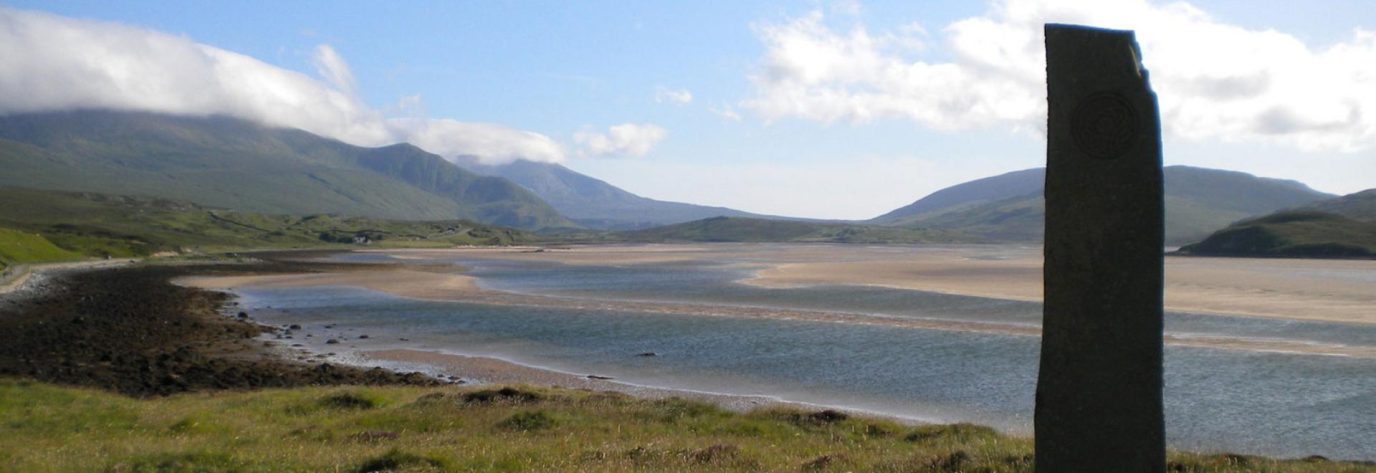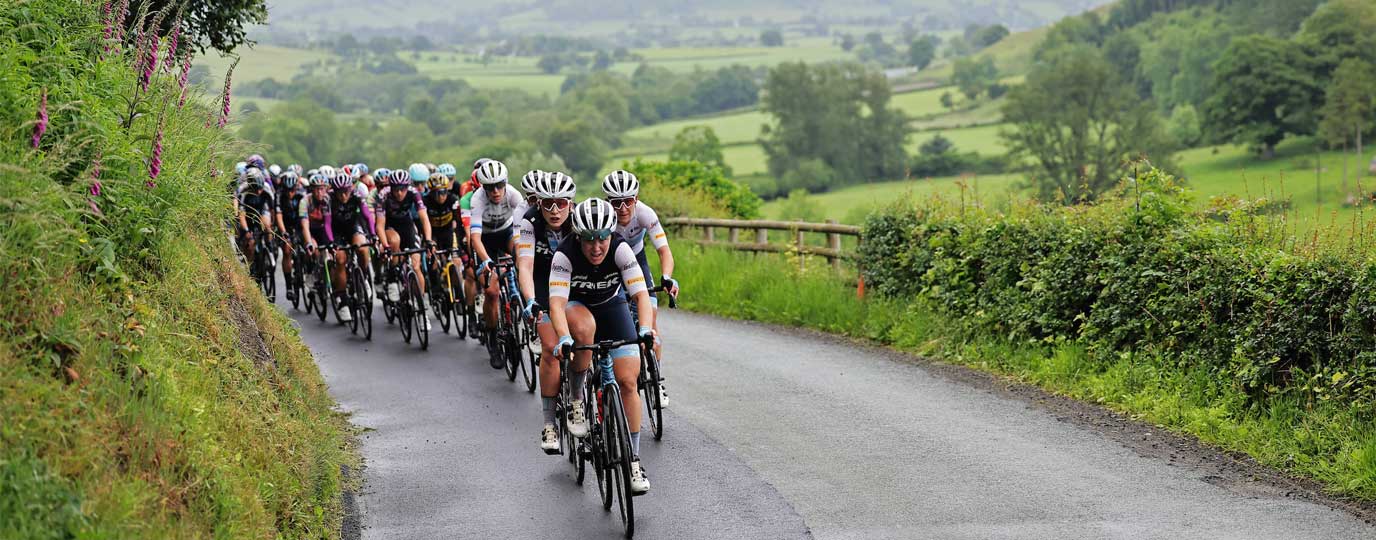Identify common trees found in Britain
In Britain there are at least fifty species of native trees and shrubs. You may have been out and about and thought to yourself, what tree is that? Here’s an easy guide to tree identification so you can brush up on your tree knowledge and identify the beautiful trees you pass.
We can look at the features of each tree to help us identify what species it is. To correctly identify trees on your next walk or ride, there are a few things you can do…
- Look at the leaves or needles
- Different features will be visible through the different seasons
- Note the surrounding area
- Put all the clues together
- Get a book which explains all the difference species or look them up online
Here are some beautiful British trees to look out for when you’re next outside and information to help you identify them.
English oak tree (Quercus robur)
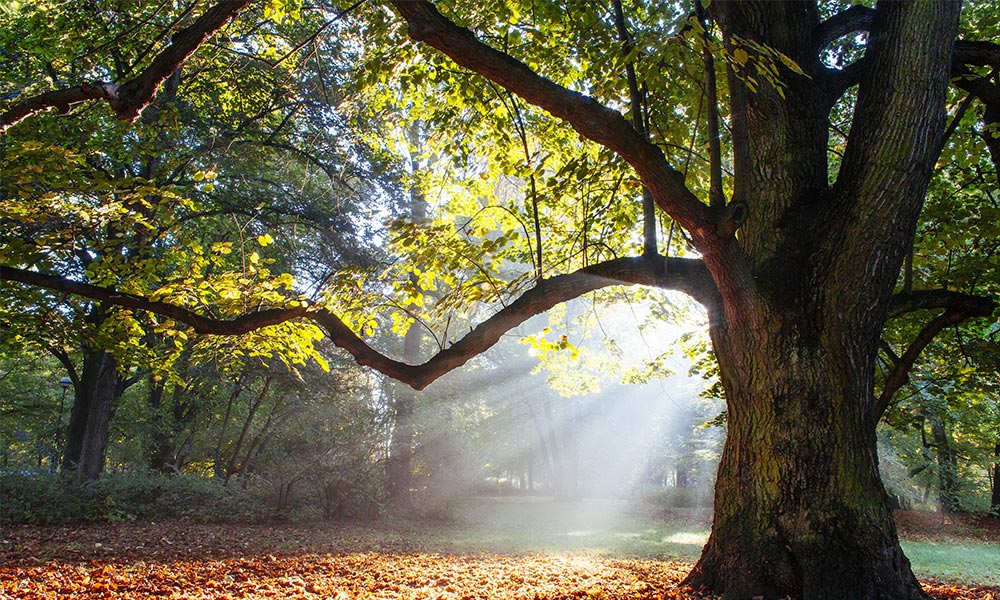
Mighty oak tree
The mighty oak, a symbol used by many organisations representing the longevity and strength of this beautiful tree. There are two native species within Britain; the English oak and the sessile oak. They support more life than any other native tree species in Britain.
The English oak is the dominant tree in most of Britain and has been planted everywhere. Oak trees are sturdy and old trees can have a girth of up to 17m. Their large branches grow from a short trunk, with a large crown. They can grow to 37m tall.
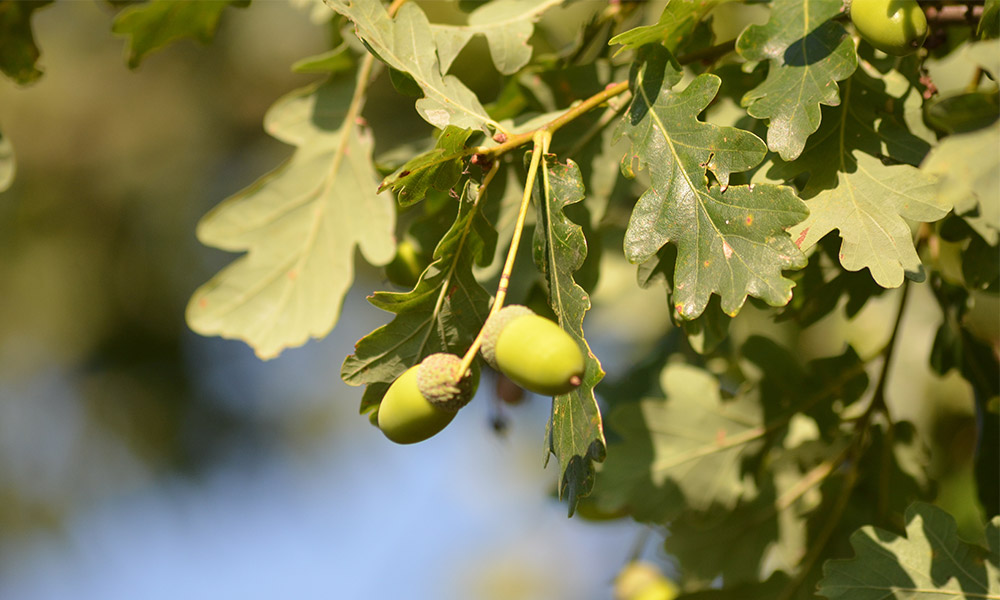
Acorns on an oak tree
The leaves of an oak are very distinctive, with three to five pairs of unequal blunt lobes and have little or no stalk. The fruit of the oak, called an acorn, is one of the best identifying features. Acorns are actually nuts and tend to grow to 2cm to 2.5cm long and grow in clusters of up to four. Acorns can be ground into flour to make bread and were a vital food for pigs which once roamed the forests. An oak’s bark starts out smooth and shiny, but as it ages it becomes fissured and cracked.
During the reign of Elizabeth I, laws were passed to promote the planting of oak and to limit its felling. The most famous oak, probably in the whole of Britain, is the Major Oak found in Sherwood Forest, Nottingham. The hollow trunk was supposedly used by Robin Hood and his merry men as a hide out.
Ash tree (Fraxinus excelsior)
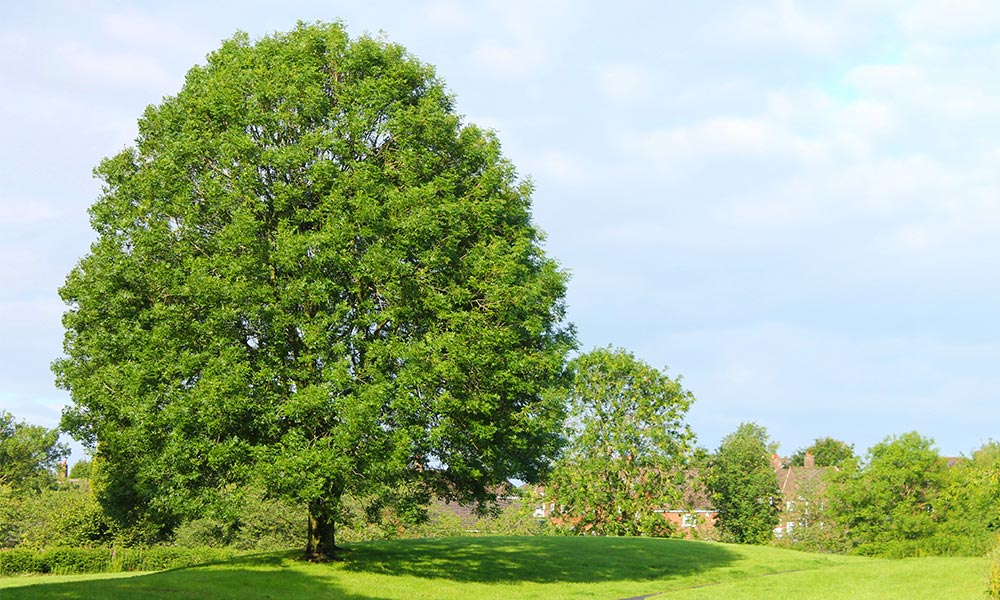
Ash tree
Ash is the third most common tree in Britain. Unfortunately, as ash dieback spreads throughout the country, it will soon be erased from the landscape.
Ash trees are tall and graceful and can reach a height of 35m. The bark is pale brown to grey and develops fissures as the tree ages. In winter, ash is easy to identify by its smooth twigs that have a distinctive black leaf buds (looks like a bishop’s mitre) that are arranged opposite each other. It is often the last tree to come into leaf in the spring.

Ash tree leaves
One prominent feature of ash is the arrangement of the leaves, they are directly opposite each other on the branches. Similarly, the branches are also located opposite to one another on the tree.
Ash tends to grow well in well-drained moist soil. It is comfortable in a cool and warm climate and does not require direct sunlight. In Norse mythology, ash was the ‘Tree of Life’ and the first man on Earth was said to have come from the tree. In Britain, the ash tree is seen as sacred by Druids and their wands are often made of ash.
Silver birch tree (Betula pendula)

Silver birch trees
The silver birch is an elegant medium-sized deciduous tree with slender drooping twigs and silver-white bark. It produces yellow-green catkins during spring and the delicate bright green leaves turn a soft yellow in autumn. As the tree matures, the bark will develop dark diamond shaped fissures and become black and rugged at the base.
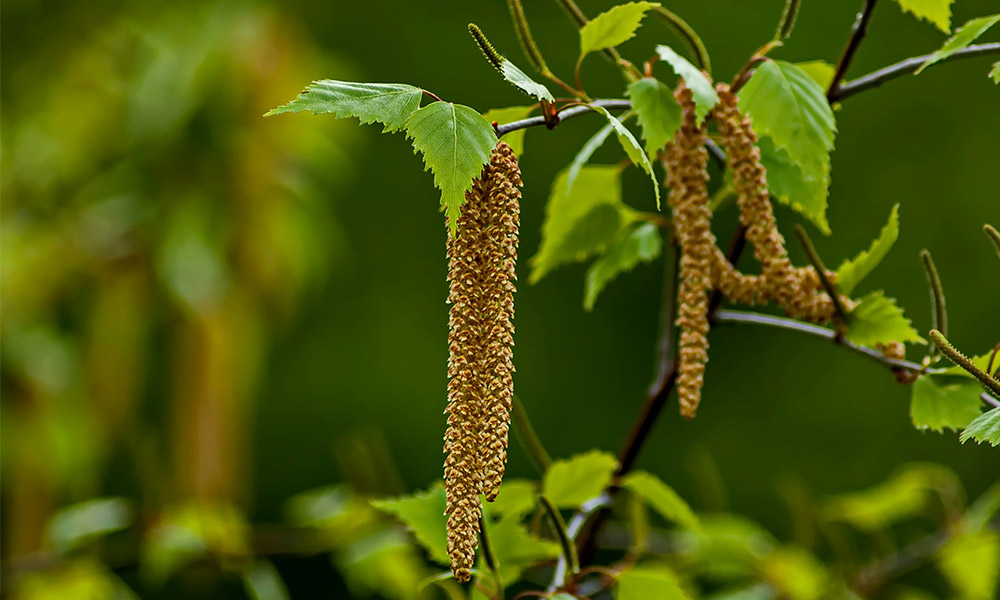
Silver birch catkins
The silver birch is a pioneer species, which is usually one of the first to colonise a site. It was one of the first trees to spread throughout the countryside after the Ice Age. In many parts of Northern Europe, birch sap is a traditional drink and used in making birch beer. The bark can also be used to make containers for food and peeled sections of the under bark can be used for fire lighting. Ash is seen as a symbol for fertility and love in the Scottish Highland folklore.
Willow tree (Salix)
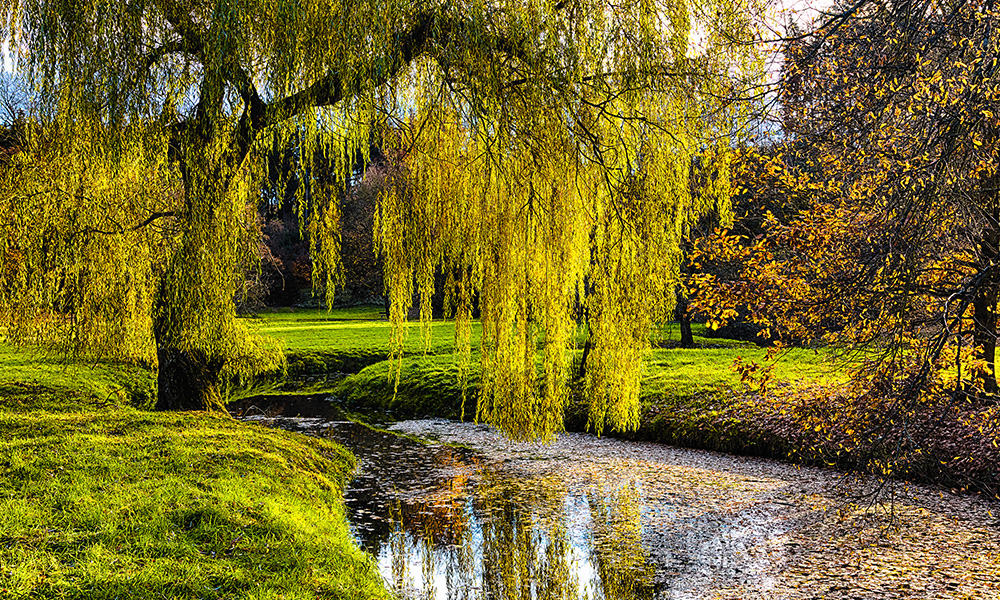
Willow tree (Salix)
There are many different species of willow to be found in the Northern Hemisphere, primarily in moist soils. The most common in Britain are crack willow and white willow and the two are hard to tell apart.
These mature trees can grow up to 25m in height. The bark tends to be a dark brown and develops deep fissures with age. The twigs are slender, flexible, shiny and yellow-brown in colour. The leaves are lance shaped, long and slender, green on their tops and a light green underneath. Some species do have narrower leaves.

Willow tree leaves
Willows have been used to make living fences or even sculptures and the branches are commonly used in basketry and weaving, as the wood is flexible enough once it has been soaked in water. In Biblical times, the willow was seen as a tree of celebration
Beech tree (Fagus sylvatica)
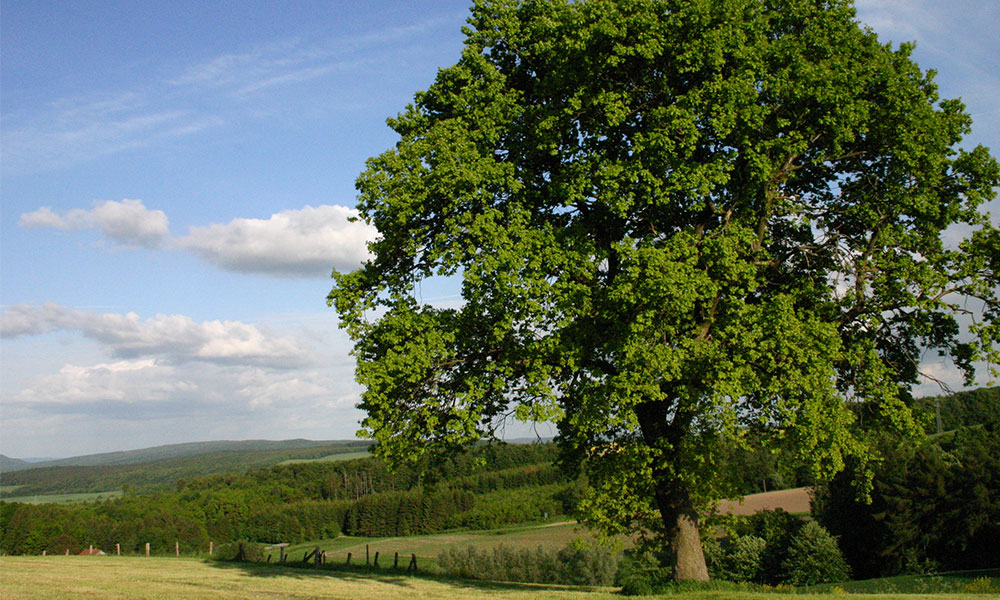
Beech tree (Fagus sylvatica)
The common beech is a large deciduous tree with a majestic broad spreading crown. They can live for hundreds of years, with coppiced stands living for over a thousand years!
The bark is smooth, thin and grey in colour, often with slight horizontal etchings. The reddish brown torpedo shaped leaf buds are sharply pointed. It is one of the few trees that holds onto its leaves throughout winter. The young leaves are lime green with silky hair which becomes a darker green as they mature and also less hairy. They are between 4-9cm long, oval and pointed at the tip with wavy edges.
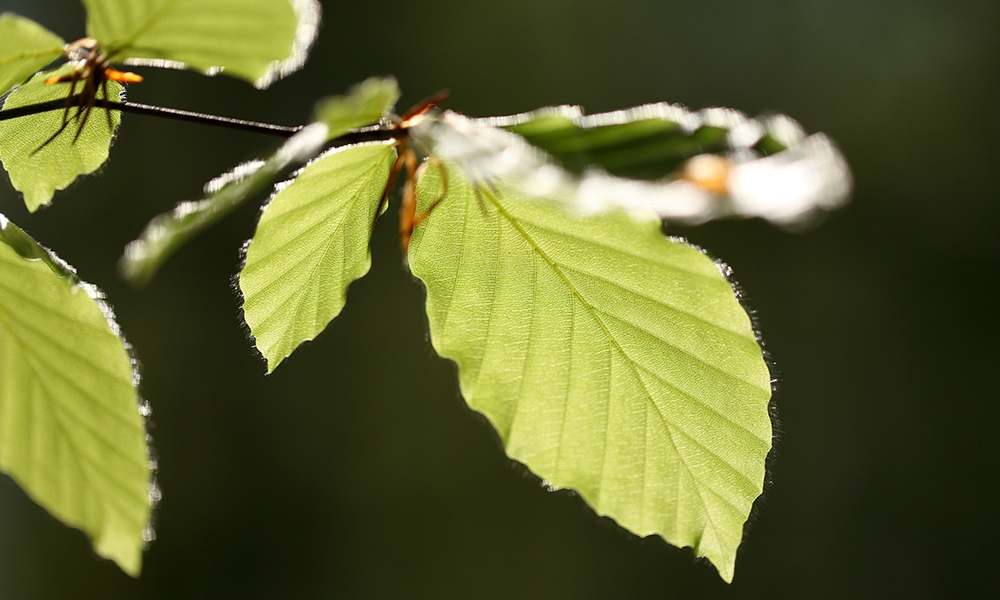
Beech tree leaves
Beech trees require a humid atmosphere and well-drained soil. During autumn the beech produces copious quantities of edible nuts or masts. These were once fed to pigs and in France they are sometimes roasted as a coffee substitute.
Some of the most famous, The Dark Hedges, which is an avenue of beech trees, were used as a backdrop in The Game of Thrones. The beech is also seen as a symbol of femininity and considered the queen of British trees.
Hawthorn tree (Crataegus monogyna)
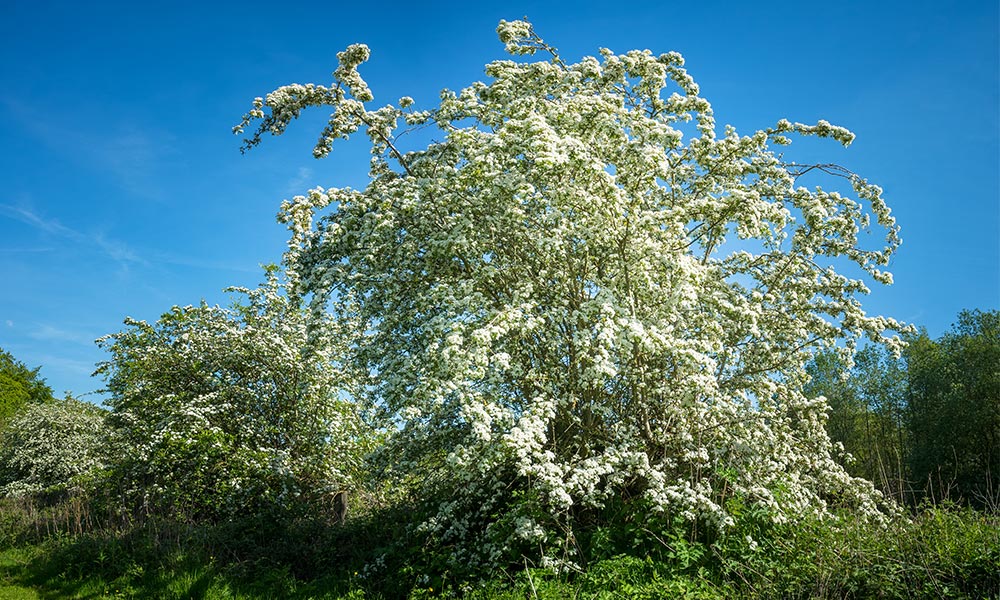
Hawthorn tree (Crataegus monogyna)
Hawthorn can be a shrub in a hedgerow or can grow to become a small tree 5 to 12 metres tall. The young stems of a hawthorn tree bears sharp thorns and because of these it has been used to create livestock hedges.
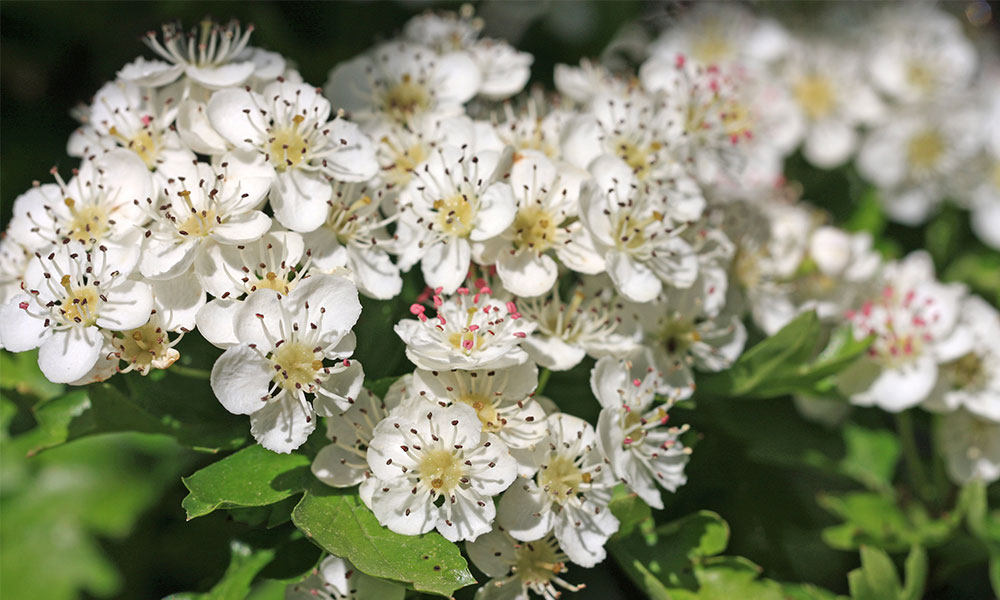
Hawthorn flowers
The leaves are roughly as broad as they are long, about 6cm. They are small and deeply lobed. The hawthorn flowers in early spring and is known as May blossom. They appear after the leaves have emerged and they are highly scented with five white petals.
In autumn, the flowers form 1cm long dark red berry-like fruits known as ‘haws’. These can be collected to make jams, jellies and fruit leathers. The young leaves, flower buds and young flowers are all edible. They can be added to green salads. Over 300 species of insect rely on this as food!
Rowan tree (Sorbus aucuparia)

Rowan tree (Sorbus aucuparia)
Also known as mountain ash, the rowan tree is a fast-growing pioneer species, that rarely grow above 15m in height. It can tolerate cold and poor soil conditions and grows at a higher altitude than any other tree in Britain.
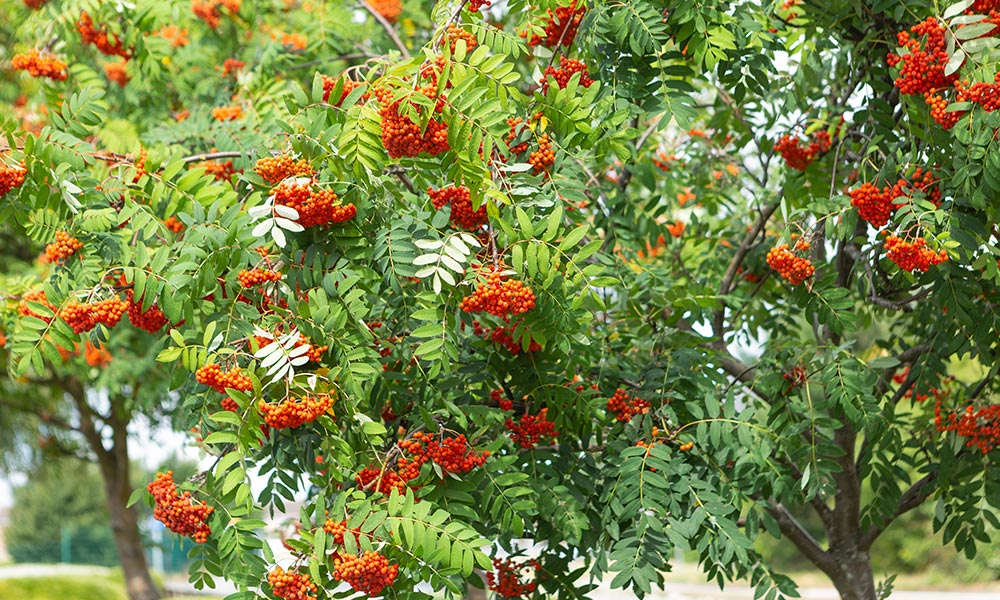
Rowan tree berries
Like the ash tree, the leaves are long, compound with 9-15 paired leaflets. Each leaf is serrated with many small teeth along the edge. The bark is smooth, silver-grey and shiny when wet. The flowers have five creamy-white petals and form dense clusters. These then develop into bright red berries in August and September.
Rowan was widely planted by houses as a protection against witches! Cutting down a rowan was considered taboo in Scotland. The wood was used for stirring milk to prevent it from curdling. Rowan berries are edible (but sour), rich in Vitamin C and can be used to make a tart jam.
Small leaved lime tree (Tilia cordata)
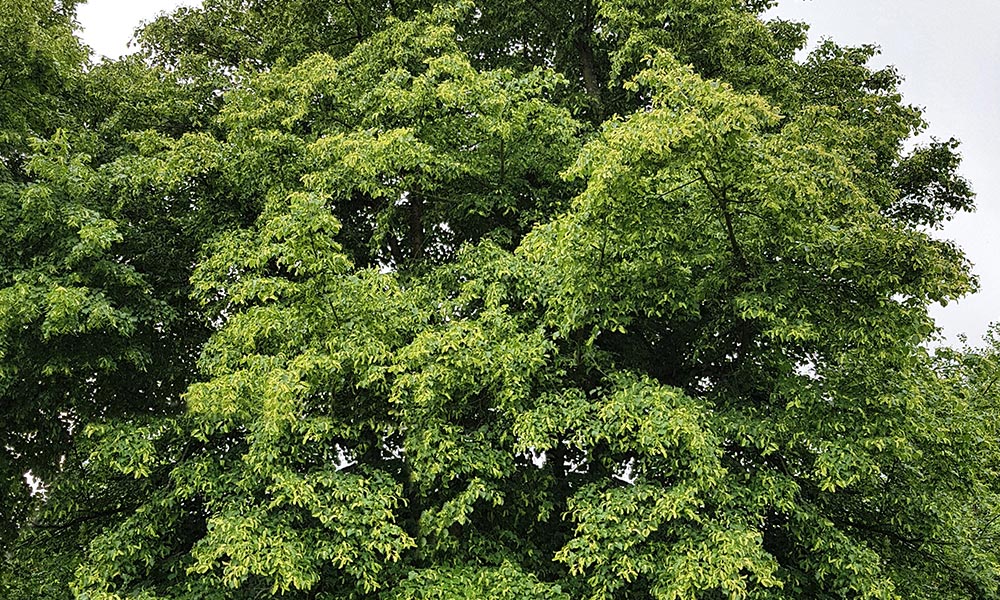
Small leaved lime tree (Tilia cordata)
There are at least 10 species of lime tree to be found in Britain. The three most common are the common lime, broad-leaved lime and the small-leaved lime. These are dominant trees in the forests that formed in Britain after the Ice Age. They can often be seen in parks and city streets. They are sometimes known as lindens or basswoods Lime trees do not produce the citrus fruit we know as limes. The word lime is believed to come from the old English word ‘lind’.
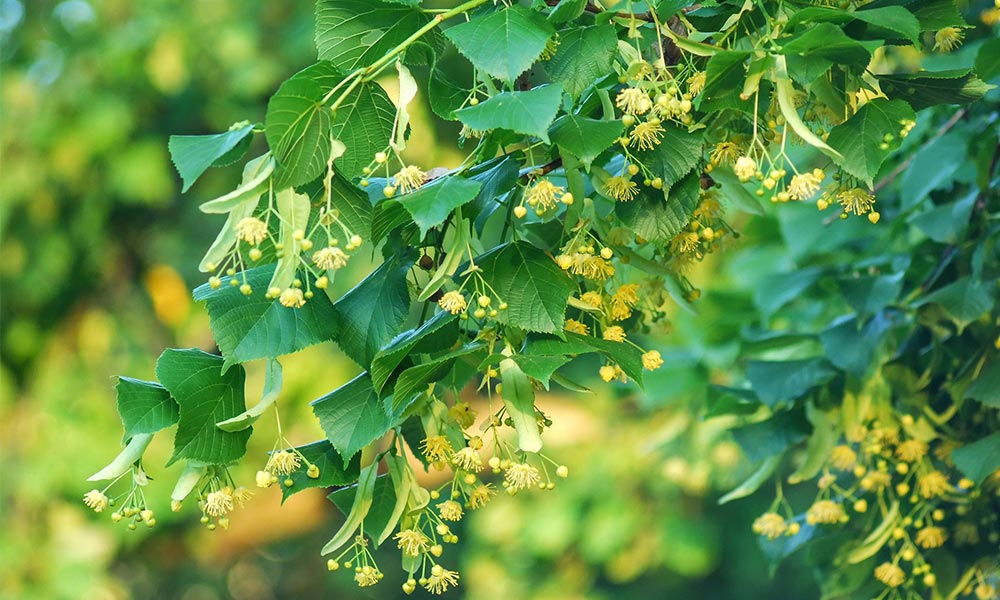
Small leaved lime tree flowers
Lime is a large deciduous tree that can grow more than 20m high. They have simple broad leaves and the two halves are not symmetrical. There are many small teeth along the edge of the leaf. Lime attracts aphids which feed on the leaves and produce a sticky honeydew. Anyone who has parked under a lime tree in spring will know the consequences of this.
The flowers are yellow-white and have five petals and sepals which hang from a long narrow leaf-like structure. The flowers can be collected to make a pleasant mildly sweet tea. The bark is grey with darker grey fissures. The inner bark was used by the Romans and is still used today, to make rope and cordage.
Western red cedar tree (Thuja plicata)
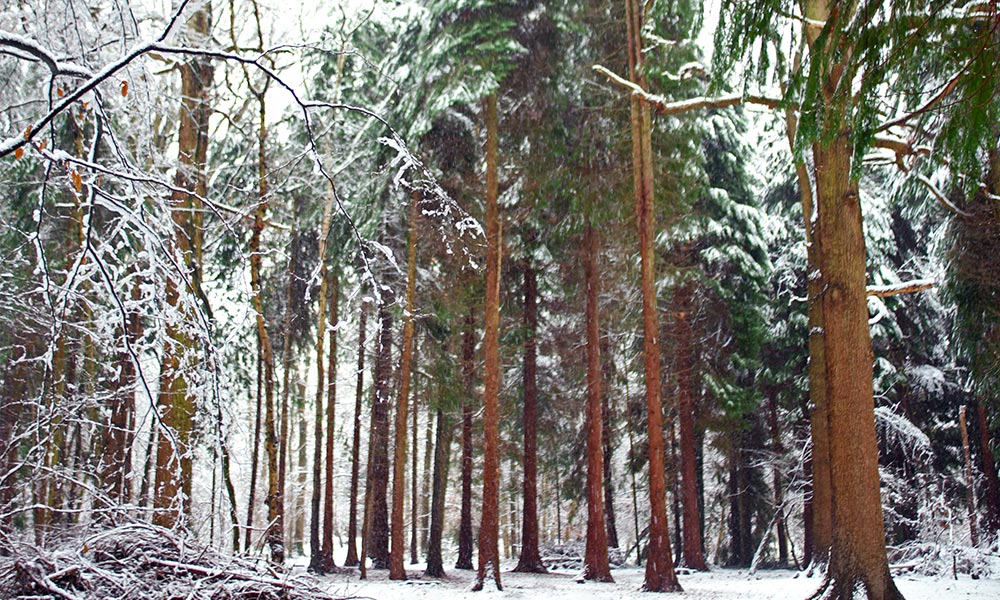
Western red cedar tree (Thuja plicata)
It was first introduced to Britain in 1853 and is native to Western Canada and the USA.
The western red cedar can grow rapidly and is widely planted in gardens, parks and forestry plantations. On the Pacific Coast they can reach a height of up to 65m and some specimens can live to be over a thousand years old.
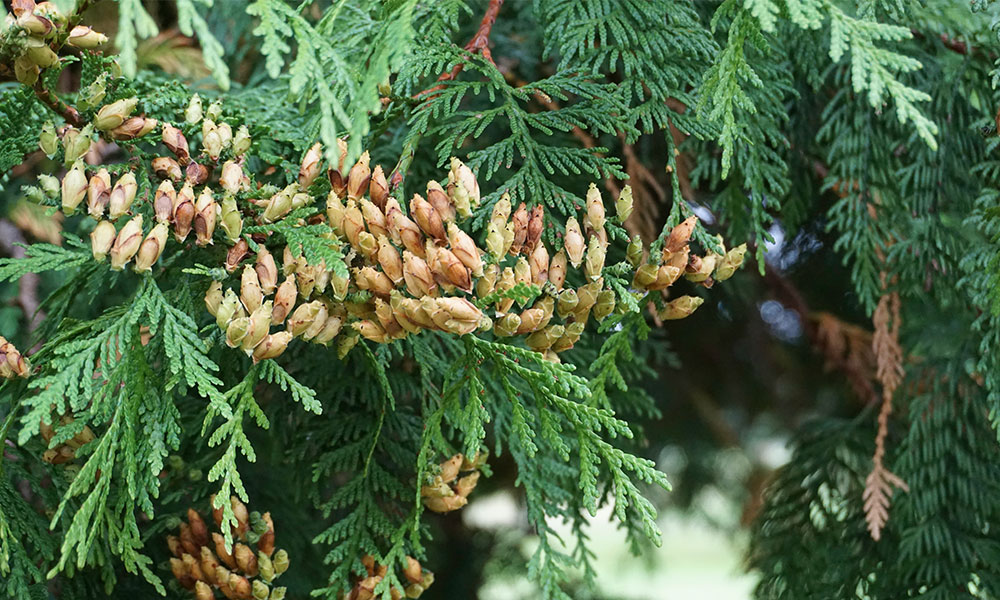
Western red cedar leaves
The leaves of the tree are flat sprays of foliage with scale-like leaves. The sprays grow in opposite pairs at 90 degrees to each other. They are strongly aromatic and when crushed, smell of pear drops or pineapple. The bark of the western red cedar is deep reddish brown and ridged.
The tree has been used for centuries by the tribes of the northwest coast of America, the bark and roots are used for making cordage, ropes, blankets and clothing. In addition to using the wood to make totem poles, it was also used for the curing and cooking of fish.
Now you know how to identify some of the most common trees in Britain, head outside and see which species you can spot!

